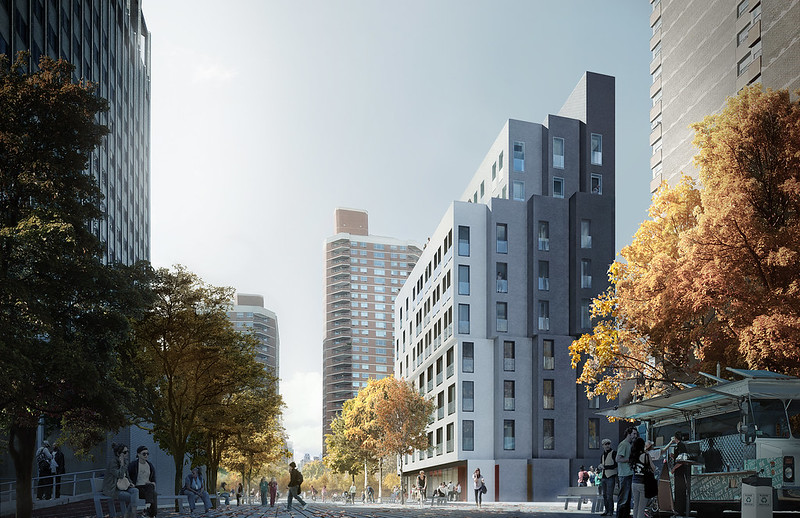
Housing in focus (photo: Mayor's Office)
On June 27, most people in this city will do nothing out of the ordinary. More than three-quarters of New Yorkers will go about their day like any other Tuesday.
But the remaining 25% or so — if we’re lucky — will get to decide most of the 51 members of the New York City Council. The majority of those voters (including those who vote early or by mail) will also cast a ballot for a district attorney, judge, or other local office.
In yet another New York City election with such low turnout, lots of things can make the difference between winning and losing – which candidate had a friendly post shared on the local parents’ Facebook group or who proposed a policy that ticked off a particularly motivated interest group, for example. Unfortunately, these factors can push candidates to focus on small-ball, too often at the cost of the larger picture and electorate. The result is that our politics plays footsie around the edges instead of tackling the big problems.
But the truth is, there are only really two things that matter to this whole city. If we get them right, everything else gets easier. If we ignore them, we are left struggling, trying to put band-aids on our problems. This is the simple recipe: First, more people should be able to live where they want to live. Second, more people should be able to get around without a private car.
It’s news to nobody that living in New York City costs a lot of money. Life in this city is rapidly becoming unattainable to all but the wealthiest among us, and this affordability crisis is largely driven by a chronic deficit of housing. In the latest Census, we learned that New York City grew by more than 629,000 people between 2010 and 2020. Yet, during the same period, we only built 206,000 housing units. The numbers don’t add up.
We should be building housing like the life of our city depends on it, because it does. People want to live here, and we should be a city that wants them too. We are all better off when we welcome new neighbors with open arms instead of a cold shoulder – whether they are recent college graduates, retirees, immigrants, or anybody else that wants to be part of the New York story. Despite their outsized voices, this has never been a town of NIMBYs, our brand is acceptance and tolerance and opportunity. And the only way to keep this promise of our city alive for this generation and future ones is to build homes for more New Yorkers.
Policies that encourage housing abundance will make our communities safer and more vibrant. Without the heavy burden of astronomical rents, more New Yorkers will be empowered to take creative and entrepreneurial risks, and more New Yorkers will sleep better without the dangling threat of losing their homes after one bad break.
And when more people can afford to live in New York City and the communities here they want to live in, we need to make it safer, cleaner, and less expensive to get around them. That ultimately means that we need to build our city around people, not automobiles.
This manifests in what are called “complete” streets, which are reimagined with pocket parks, bike lanes, pedestrian safety improvements, accessible loading zones, and perhaps most viscerally impactful of all, containerized waste collection. The rats will hate this. The driver of a jacked-up pickup truck doing 50 in a school zone will hate this. But every time we try this, we see that New Yorkers love it.
Next, we need to think big about other forms of transit. We built 467 subway stops in the first hundred-ish years of the system – but only five stops in this millennium. Some people need a car; there are lots of valid reasons to own and operate one. This is not about banning cars, it’s about minimizing car dependency and all the negative things that come with it — crashes, pollution, noise, and isolation — and maximizing mobility and opportunity, health and happiness.
We can take big steps in that direction with new and repurposed rail service, especially in “transit deserts” outside Manhattan. Our transit system made New York a world capital in the last century. We must not allow ourselves to believe that new transportation projects are only a thing of the past.
Housing and transportation. Those are the universal issues. Depending on our lives, other things can of course certainly matter a whole lot, particularly policing and criminal justice, education, sanitation, social services, the environment and more. And within each of those areas, there is also a world of nuance. This does not diminish their very real importance.
But the big picture is simple. Make this a city that people can live in — a city where people can afford decent housing and where people can get around easily — and the rest will follow. If you’re one of the few that chooses to cast a vote on June 27, make it one for candidates that will answer these issues.
***
Ben Guttmann is a marketing executive, adjunct professor at Baruch College, and author of Simply Put: Why Clear Messages Win – and How to Design Them, to be released by Berrett-Koehler Publishers in October. On Twitter @guttmann.
***
Have an op-ed idea or submission for Gotham Gazette? Email This email address is being protected from spambots. You need JavaScript enabled to view it.




